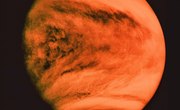
Industrial activity on Earth has contributed pollutants such as nitric oxide and sulfur dioxide to the atmosphere, and these chemicals fall to the ground as acid rain. One other planet in the solar system -- Venus -- has a similar problem, but the conditions there differ drastically from those on Earth. In fact, they are so different that some scientists see it as the least hospitable place for life in the solar system.
The Venusian Atmosphere
The surface of Venus is literally a hotbed. According to NASA, the temperature there hits 462 degrees Celsius (864 degrees Fahrenheit), which is hot enough to melt lead. Although Venus is closer to the sun than Earth, global warming -- not solar proximity -- drives the high temperatures. The atmosphere consists of mostly carbon dioxide, a greenhouse gas, and it is much denser than Earth's atmosphere -- 90 times as dense, in fact. The atmosphere also contains nitrogen and trace amounts of water vapor and sulfur dioxide.
Acid Rain on Venus
Like the acid rain on Earth, that on Venus results from the combination of sulfur dioxide and water. The two compounds exist in the cooler upper atmosphere, between 38 and 48 kilometers (24 to 30 miles) above the ground. They form clouds of sulfuric acid that condenses into droplets, but the acid rain never reaches the ground. Instead, it evaporates at a height of 30 kilometers (19 miles) and rises to again form clouds, continuing the cycle. Therefore, someone unlucky enough to be standing on the planet's surface would at least be spared a sulfuric acid rain shower.
Volcanic Activity
The sulfur dioxide in the atmosphere of Venus comes from volcanic activity. Venus has more volcanoes than any other planet in the solar system -- 1,600 major ones and more than 100,000 smaller ones. Unlike Earth's volcanoes, however, those on Venus exhibit a single form of eruption: liquid lava flow. There is no water on the surface to cause the explosive eruptions that happen on Earth. Many of the volcanoes on Venus appear to be dead, but a spike of sulfur dioxide in the atmosphere and its subsequent decline, recorded by the European Space Agency's Venus Express Orbiter, suggests the possibility of a recent eruption.
The Sulfur Dioxide Cycle
In 2008, the Express Orbiter detected a layer of sulfur dioxide higher in the Venusian atmosphere than was expected. The layer, which is between 90 to 100 kilometers (56 to 68 miles) above the surface, baffled scientists, who believed that the intense solar radiation at that altitude should destroy any sulfur dioxide that had not combined with water to form sulfuric acid. The discovery shows that some sulfuric acid droplets evaporate at altitudes higher than previously thought and raises serious questions about proposals to inject sulfur dioxide -- which deflects sunlight -- into Earth's atmosphere to combat global warming.
References
About the Author
Chris Deziel holds a Bachelor's degree in physics and a Master's degree in Humanities, He has taught science, math and English at the university level, both in his native Canada and in Japan. He began writing online in 2010, offering information in scientific, cultural and practical topics. His writing covers science, math and home improvement and design, as well as religion and the oriental healing arts.
Photo Credits
Digital Vision./Digital Vision/Getty Images
